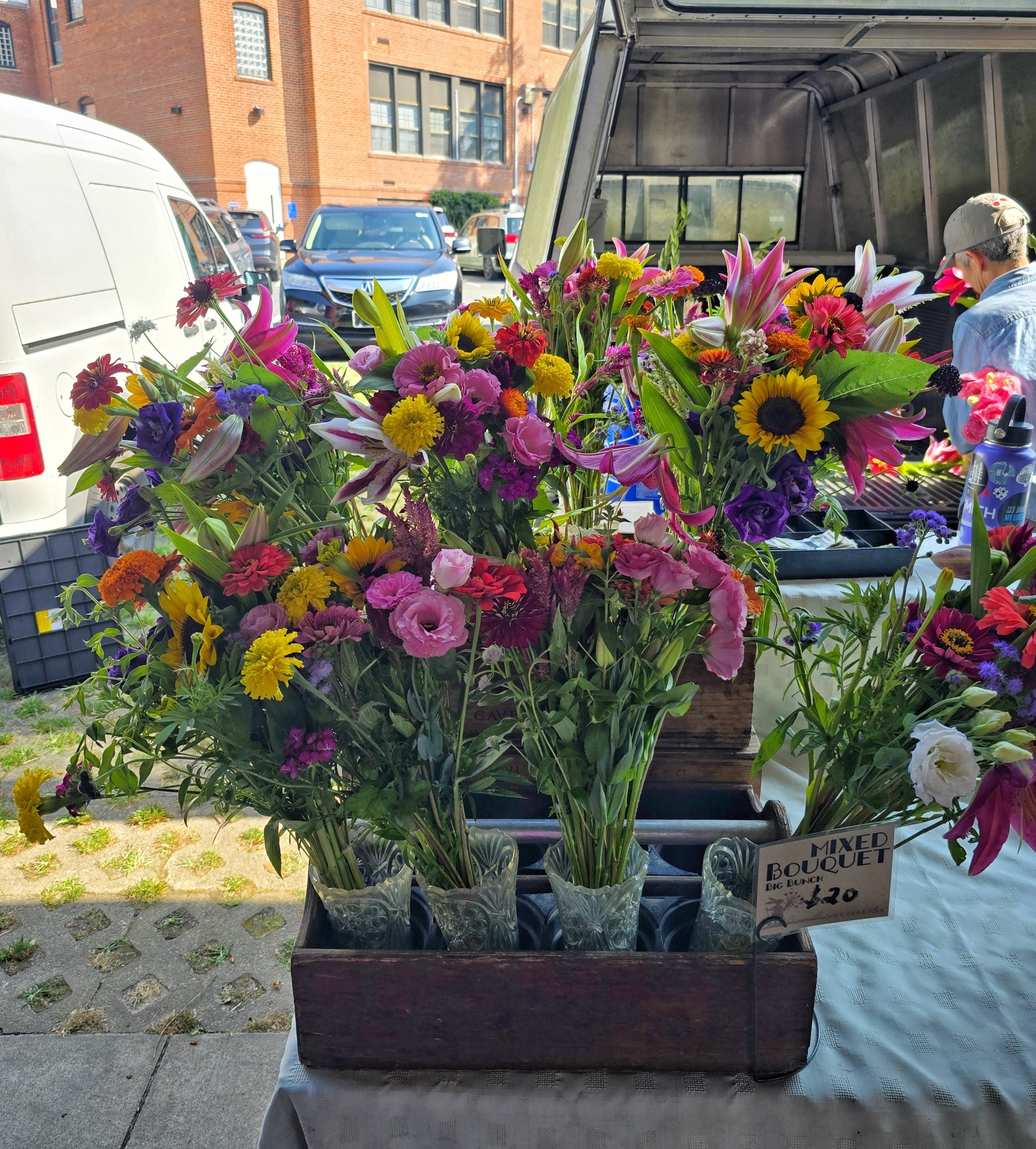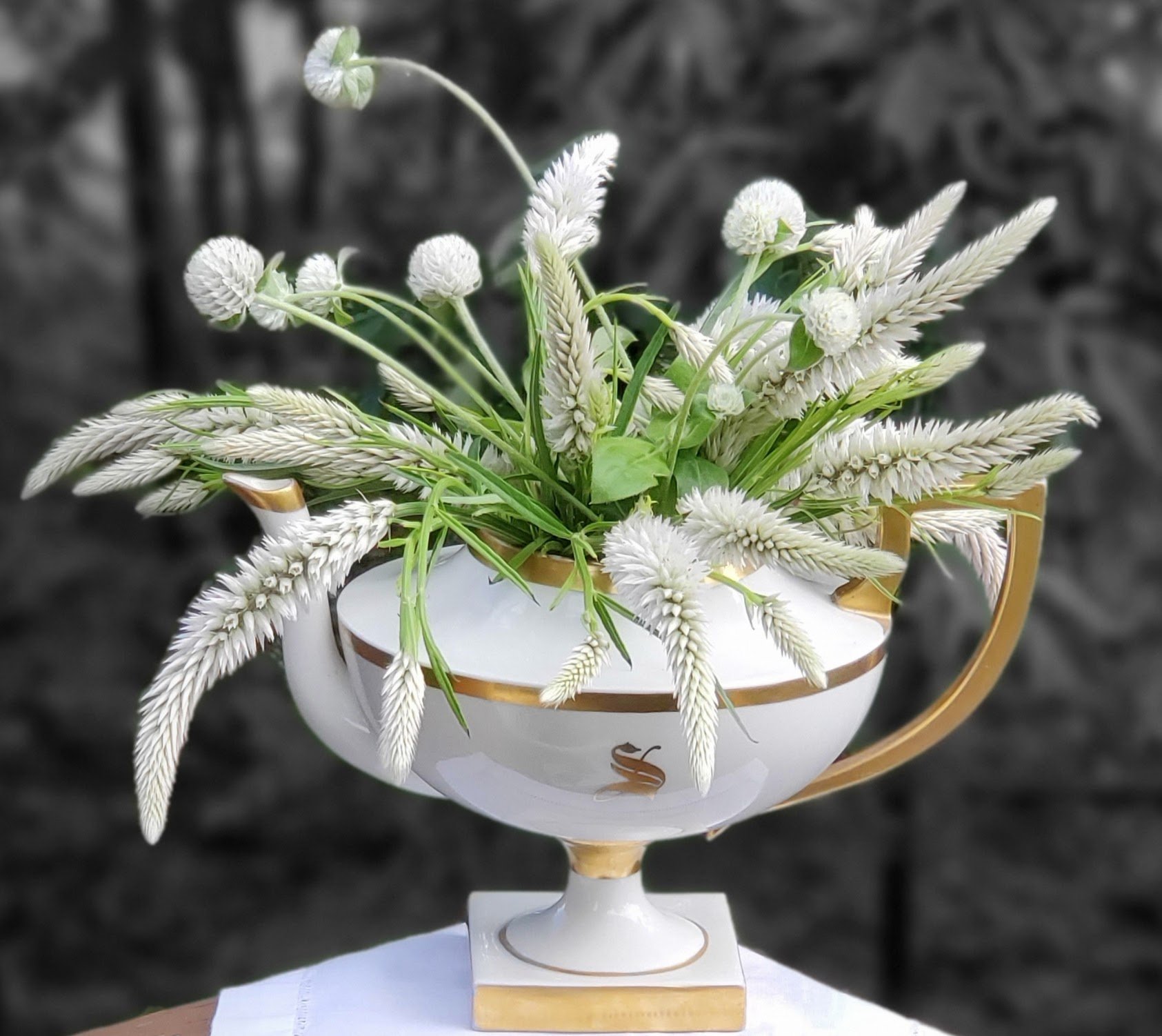Discover the Beauty of Flower Farmers: A Journey from Farm to Vase
A vibrant sea of color at a local flower farmer's stall.
In my happy place.
My Saturday Morning Ritual
There's something about a Saturday morning here in Chapel Hill. It’s where I feel the structure of the work week finally give way to the ease of the weekend. When I head to the farmers market, the air is usually buzzing—the gentle hum of conversations, the smell of fresh bread from one stall and hot coffee from another. It’s a wonderful scene. But if I’m being honest, my real mission, my weekly ritual, is a beeline for the flower stalls. It's more than just a place to buy things; it's a community experience that fills me with a special kind of joy. It's my favorite part of the week, and I'd love to bring you along on my little journey from their farm to my vase.
A closer look at the anemones once they've fully opened. Aren't their dark centers stunning?
A Closer Look: Getting to Know the Anemone
Every flower at the market has its own unique story and secrets. It would take a whole book to tell them all! So today, I wanted to take you deeper into the story of the flower that truly captured my heart on this trip: the anemone.Walking through the market, my eye was immediately drawn to a bucket of anemones. You probably know the ones I mean—they look a bit like a poppy or a daisy, but they have these dramatic, dark centers that just pull you in. They come in every color imaginable, from the purest whites to deep, moody purples. A little tip I've learned from the farmers is to pick a bunch where some of the buds are still a little shy and closed up. It’s a bit of a secret—those are the ones that will open up beautifully at home and last the longest. I always ask how long they'll last in a vase, and the answer is usually a good three to six days of pure beauty.
I just love how elegant parrot tulips are. The way their ruffled petals unfurl feels like a little work of art on my table.
Bringing the Magic Home
Turning my market treasures into a personal masterpiece. I love how the ruffled parrot tulip stands out in this arrangement. When I get my flowers home, the fun really starts. I'm no professional florist, and you don't have to be either. My process is pretty simple: I trim the stems, pull off a few of the lower leaves, and just start playing. Sometimes I’ll put a few stems in a little bud vase for the kitchen counter. Other times, I'll take a big, vibrant bunch and put them right in the middle of the dining table where they can be the star of the show. There’s no right or wrong way to do it. Just placing them in a vase creates a living sculpture that sparks conversation and makes any meal feel like a special occasion.
My Tips for Bringing Home the Best Blooms
Over the years of my weekly flower runs, I’ve learned a few little secrets that make all the difference between a bouquet that’s pretty for a day and one that shines all week. It all starts the moment you're standing in front of those colorful buckets.
🌿 Talk to the Farmer. This is my number one tip! They are the absolute experts. Don't be shy—ask them what’s freshest that morning or what they’re most excited about. I often ask, "If you were taking a bouquet home for your own table today, what would be in it?" They'll give you the best inside scoop.
🌿 Look for Tighter Buds. It’s tempting to grab the biggest, most wide-open flowers, but the secret to longevity is choosing stems where many of the buds are still a little shy and closed up. This means you get the joy of watching them open up over several days right in your own home.
🌿 Look for Strong, Healthy Stems. The flower farmers at the market are amazing and always bring their best, but this is a great little tip for buying flowers anywhere. You're looking for stems that feel firm and strong, with vibrant, healthy green leaves from top to bottom. This is a wonderful sign that the flowers are super fresh and have been well-hydrated from the moment they were picked—and that's the real secret to a long and happy life in your vase.
🌿 Bring a Bucket. This is my game-changer tip. I keep a clean bucket with an inch or two of water in the back of my car. As soon as I buy my flowers, they go right into the water. This prevents them from getting stressed and wilted on the car ride home, especially on a hot summer day.
A close-up of a simple peony arrangement, highlighting the contrast between large, open pink peonies and smaller, closed buds.
From Their Farm to Your Vase: Making Them Last
Okay, you've brought your beautiful flowers home. Now what? With just a few simple steps, you can extend that market-fresh beauty for a full week or more.
🌿 Give Them a Fresh Cut. As soon as you get home, recut every single stem. The ends have likely dried out a bit since they were first cut at the farm. Trim about an inch off the bottom at a sharp 45-degree angle. This creates more surface area for the stems to drink up water and prevents them from sitting flat on the bottom of the vase.
Refreshing the water for a bouquet of farmers market flowers by pouring from a pitcher into a clean vase.
🌿 Use a Squeaky Clean Vase. Bacteria is the number one enemy of fresh-cut flowers. Make sure the vase you choose is washed with hot, soapy water and is completely clean before you add your flowers. Any lingering bacteria will clog the stems and prevent them from hydrating properly.
🌿 Feed Your Flowers. If the farmer gives you one of those little packets of flower food, use it! It’s not a gimmick. It contains three key things: sugar (food for the blooms), an acidifier (to help the water move up the stems), and a biocide (to kill bacteria). If you don't have a packet, you can make your own simple version: for a quart of water, add 1 teaspoon of sugar and 2-3 drops of bleach or a teaspoon of clear vinegar.
🌿 Now for the Tip That Surprises Everyone: Keep Them Away From Your Fruit Bowl! This is so important. As fruits ripen—especially apples, bananas, and avocados—they release a natural, invisible gas called ethylene. For flowers, this gas is like a fast-forward button on the remote of their life, signaling them to age, wilt, and drop their petals much, much quicker. So, display your beautiful bouquet in the living room or on your nightstand, but try to avoid placing it right next to your kitchen fruit bowl.
🌿 Change the Water Every Other Day. Flowers are thirsty! Topping up the vase with fresh, cool water and completely changing it out every two days will wash away any growing bacteria and give them the fresh drink they need to keep shining. A quick re-trim of the stems when you change the water is a pro move, too!
I just love the unique textures in this arrangement. I love how the fuzzy Globe Amaranth and feathery Wheat Celosia are perfectly complemented by the gold accents of one of my favorite vintage teapots.
The Story Behind the Stems
This whole journey, from seeing the flowers at the market to arranging them in my home, really opens my eyes to the artistry and dedication of our local flower farmers. It reminds me of my mother at the restaurant. Mama’s goal was always to please her customers, to give them a taste of home. These farmers are doing the same thing, just with soil and petals instead of pots and pans. They’re sharing a piece of their passion with you. So next time you're at the market, I hope you’ll pause for a moment. Appreciate the story behind each bloom and the hard work it represents.
It’s a simple joy, isn't it? Celebrating the beauty of what these farmers can grow... It’s a chance to cherish the journey from their farm to our vase and to keep unearthing the little treasures that await us at the farmers market each week.
There’s a special joy in knowing that fellow flower lovers everywhere are finding their own treasures this weekend.
The next time you bring home flowers from your local market, I would love to see what you chose. Feel free to share a photo and tag me on Instagram [@spring.council]—I love seeing what’s blooming in your corner of the world.
Yours in bloom,
Spring
Collards and Caviar








